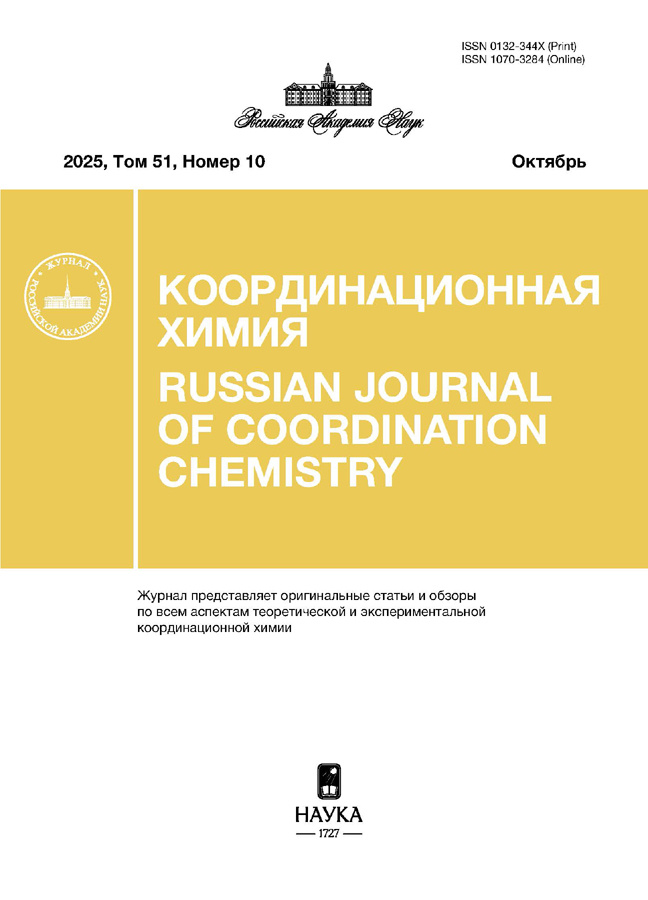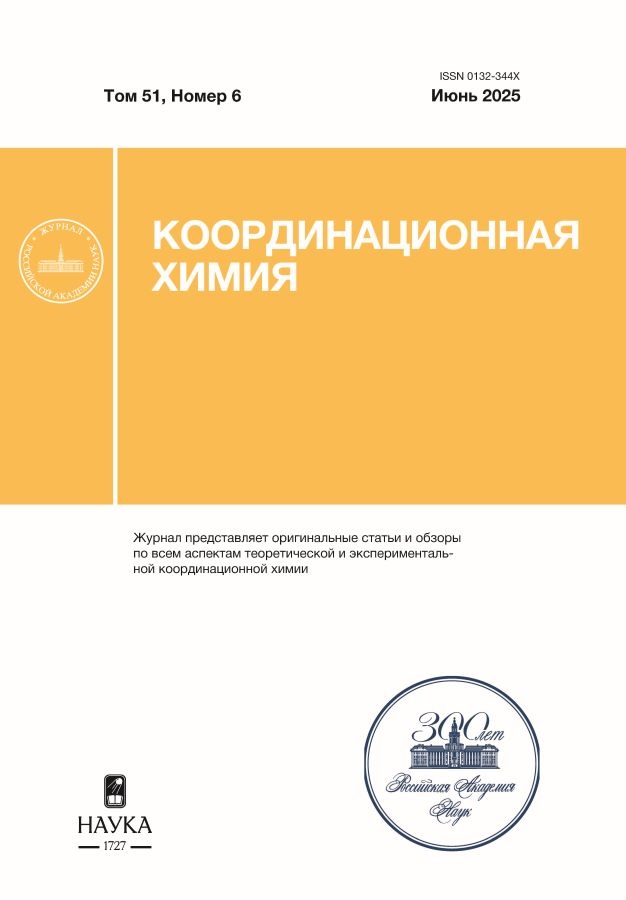О взаимодействии комплексов меди(II) Cu(Gly)₂⁰, Cu(Bipy)Gly⁺ и Cu(Bipy)₂²⁺ с глутатионом
- Авторы: Миронов И.В.1, Харламова В.Ю.1
-
Учреждения:
- Институт неорганической химии им. А. В. Николаева СО РАН
- Выпуск: Том 51, № 6 (2025)
- Страницы: 377-386
- Раздел: Статьи
- URL: https://medjrf.com/0132-344X/article/view/687253
- DOI: https://doi.org/10.31857/S0132344X25060033
- EDN: https://elibrary.ru/KILFPQ
- ID: 687253
Цитировать
Полный текст
Аннотация
Исследовано взаимодействие трех комплексов меди(II) — Cu(Gly)₂⁰, Cu(Bipy)₂²⁺ и Cu(Bipy)Gly⁺ — с глутатионом в водном растворе (pH 7.4, 0.2 M NaCl, 25°C, сCu = (1–10) × 10–4, сGSH = 1.0 × 10–3 M). Эти и аналогичные комплексы часто используются в биологических экспериментах для проверки антираковой и антимикробной активности. Показано, что в физиологических условиях комплексы меди(II) практически необратимо переходят в более устойчивую форму тиолатных комплексов меди(I). Индивидуальность исходных комплексов при этом полностью теряется. Во всех случаях редокс-взаимодействие используемых комплексов меди(II) с глутатионом протекало быстро и количественно. Основным продуктом был бистиолатный комплекс меди(I) и дисульфид глутатиона.
Ключевые слова
Полный текст
Об авторах
И. В. Миронов
Институт неорганической химии им. А. В. Николаева СО РАН
Автор, ответственный за переписку.
Email: imir@niic.nsc.ru
Россия, Новосибирск
В. Ю. Харламова
Институт неорганической химии им. А. В. Николаева СО РАН
Email: imir@niic.nsc.ru
Россия, Новосибирск
Список литературы
- Freedman J.H., Ciriolo M.R., Peisach J. // J. Biol. Chem. 1989. V. 264. № 10. P. 5598.
- Кошенскова К.А., Баравиков Д.Е., Нелюбина Ю.В. и др. // Коорд. химия. 2023. Т. 49. № 10. С. 632. https://doi.org/10.31857/S0132344X23600212 (Koshenskova K.A., Baravikov D.E., Nelyubina Yu.V. et al. // Russ. J. Coord. Chem. 2023. V. 49. № 10. P. 660) https://doi.org/10.1134/S1070328423600730
- Śliwa E.I., Śliwińska-Hill U., Bażanów B. et al. // Molecules. 2020. V. 25. № 3. P. 741.
- Ruiz-Azuara L., Bravo-Gómez M.E. // Curr. Med. Chem. 2010. V. 17. P. 3606.
- Eremina J.A., Lider E.V., Kuratieva N.V. et al. // Inorg. Chim. Acta. 2021. V. 516. Art. 120169.
- Shakirova O.G., Morozova T.D., Kudyakova Y.S. et al. // Int. J. Mol. Sci. 2024. V. 25. P. 9414.
- Eremina J.A., Smirnova K.S., Klyushova L.S. et al. // J. Mol. Struct. 2021. V. 1245. Art. 131024.
- Speisky H., Gómez M., Carrasco-Pozo C. et al. // Bioorg. Med. Chem. 2008. V. 16. P. 6568.
- Galindo-Murillo R., García-Ramos J.C., Ruiz-Azuara L. et al. // Nucleic Acids Res. 2015. V. 43. № 11. P. 5364.
- Casini A., Kelter G., Gabbiani C. et al. // J. Biol. Inorg. Chem. 2009. V. 14. P. 1139.
- Gorini G., Magherini F., Fiaschi T. et al. // Biomedicines. 2021. V. 9. P. 871.
- Fernandez-Moreira V., Herrera R.P., Gimeno M.C. // Pure. Appl. Chem. 2018. V. 91. P. 247.
- Mironov I.V., Kharlamova V.Yu. // ChemistrySelect. 2023. V. 8. Art. e202301337.
- Миронов И.В., Харламова В.Ю. // Журн. неорган. химии. 2023. Т. 68. № 10. С. 1495. https://doi.org/10.31857/S0044457X23600639 (Mironov I.V., Kharlamova V.Yu. // Russ. J. Inorg. Chem. 2023. V. 68. № 10. P. 1487). https://doi.org/10.1134/S003602362360185X
- Crmarić D., Bura-Nakić E. // Molecules. 2023. V. 28. P. 5065.
- Rigo A., Corazza A., di Paolo M.L. et al. // J. Inorg. Biochem. 2004. V. 98. P. 1495.
- Smith R.C., Reed V.D., Hill W.E. // Phosphorus, Sulfur, Silicon Relat. Elem. 1994. V. 90. P. 147.
- Карякин Ю.В., Ангелов И.И. Чистые химические вещества. М.: Химия, 1974. С. 235.
- Bratsch S.G. // J. Phys. Chem. Ref. Data. 1989. V. 18. № 1. P. 1.
- Jocelyn P.C. // Eur. J. Biochem. 1967. V. 2. P. 327.
- Walsh M.J., Ahner B.A. // J. Inorg. Biochem. 2013. V. 128. P. 112.
- Österberg R., Ligaarden R., Persson D. // J. Inorg. Biochem. 1979. V. 10. P. 341.
- Königsberger L.-C., Königsberger E., Hefter G. et al. // Dalton Trans. 2015. V. 44. P. 20413.
- Perrin D.D. Stability сonstants of metal-ion complexes. Pt B: Organic ligands. New York: Pergamon Press, 1979. 1263 p.
- Speisky H., Gómez M., Burgos-Bravo F. et al. // Bioorg. Med. Chem. 2009. V. 17. P. 1803.
- Ngamchuea K., Batchelor-McAuley C., Compton R.G. // Chem. Eur. J. 2016. V. 22. № 44. P. 15937.
- Drochioiu G., Ion L., Ciobanu C. et al. // Eur. J. Mass Spectrom. 2013. V. 19. P. 71.
- Aliaga M.E., López-Alarcón C., Bridi R. et al. // J. Inorg. Biochem. 2016. V. 154. P. 78.
- Багиян Г.А., Королева И.К., Сорока Н.В. и др. // Кинетика и катализ. 2004. Т. 45. № 3. С. 398 (Bagiyan G.A., Koroleva I.K., Soroka N.V. et al. // Kinet. Catal. 2004. V. 45. № 3. P. 372). https://doi.org/10.1023/B:KICA.0000032171.81652.91
- Mejia C., Ruiz-Azuara L. // Pathol. Oncol. Res. 2008. V. 14. P. 467.
- Griesser R., Sigel H. // Inorg. Chem. V. 9. № 5. P. 1238.
- Raydan D., Rivas-Lacre I.J., Lubes V. et al. // J. Mol. Liq. 2020. V. 302. Art. 112595.
- Seko H., Tsuge K., Igashira-Kamiyama A. et al. // Chem. Commun. 2010. V. 46. P. 1962.
- Huang R., Wallqvist A., Covell D.G. // Biochem. Pharmacol. 2005. V. 69. P. 1009.
Дополнительные файлы

















